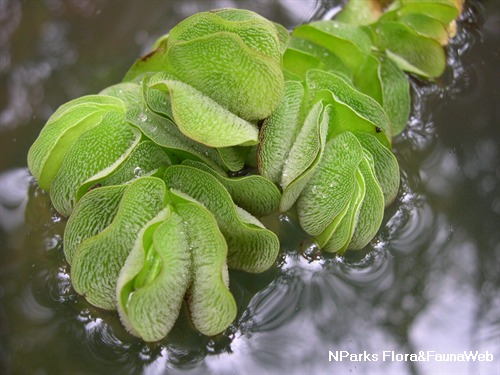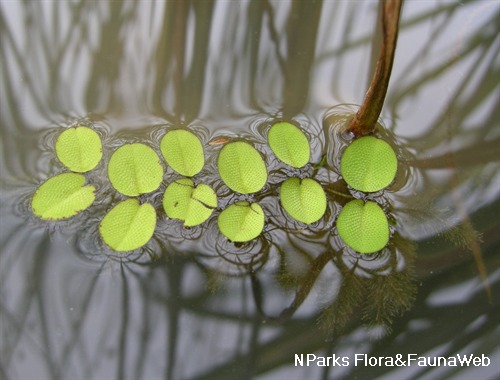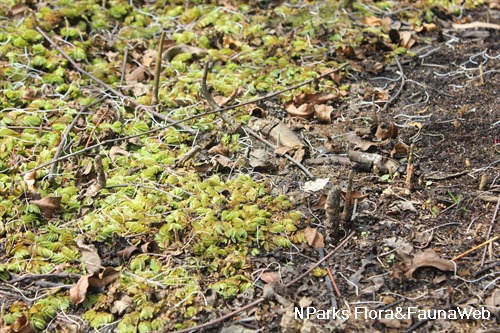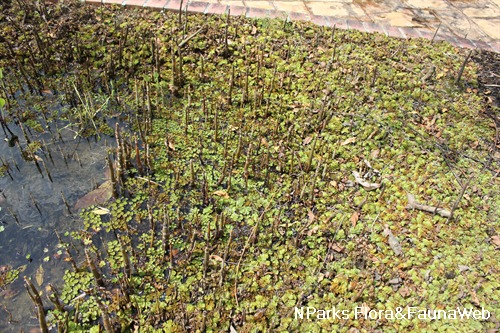
Back
Salvinia adnata Desv.
| Family Name: | Salviniaceae |
| Common Name: | Water Spangle, Giant Salvinia, Aquarium Watermoss |
Name
Classifications and Characteristics
| Plant Division | Ferns & Lycophytes (Non-Seed Vascular Plants) (Fern) |
|---|---|
| Plant Growth Form | Aquatic & Hydrophyte (Floating Aquatic) |
| Mode of Nutrition | Autotrophic |
Biogeography
| Native Distribution | Brazil |
|---|---|
| Native Habitat | Aquatic (Freshwater Pond / Lake / River) |
| Preferred Climate Zone | Tropical |
| Local Conservation Status | Non-native |
Description and Ethnobotany
| Growth Form | Aquatic fern that lacks roots. |
|---|---|
| Roots | It doesn't have roots. |
| Foliage | It has 2 types of fronds, floating and submerged fronds. The floating fronds are approximately oval (0.5 - 4 cm long), being heart-shaped near the base and rounded at the tip. They are densely covered in white, bristly hairs. The fronds grow bigger in size and the edges crinkle up when growing in waters congested with Salvinia molesta. The submerged fronds are brown, long and feathery, resembling roots. Each plant is composed of 2 floating fronds and 1 submerged frond. |
| Flowers | It doesn't have flowers, because it is a fern. |
| Fruit | It doesn't have fruits, because it is a fern. |
| Cultivation | This species grows aggressively and care needs to be taken not to allow it to spread into natural water bodies. (In the 1970s, Singapore's reservoirs were covered by this species.) When this species grows in a dense population, the floating fronds become larger and more crinkled. It has a high tolerance for poor growing conditions. |
| Ethnobotanical Uses | Others: This species has phytoremediation potential, because it accumulates chromium, as well as absorbs nitrogen and phosphorous. It has a wide variety of uses, such as agricultural purposes (fodder, mulch and compost) and handicrafts (paper making). |
Landscaping Features
| Landscape Uses | Phytoremediation (Ground / Water Contaminant(s)) |
|---|---|
| Usage Hazard - Cons | Invasive / Potentially Invasive |
Plant Care and Propagation
| Light Preference | Semi-Shade |
|---|---|
| Water Preference | Lots of Water |
| Plant Growth Rate | Fast |
| Maintenance Requirements | Low |
| Potential Problems | It grows aggressively and could spread into natural waterbodies. |
| Propagation Method | Spore, Division |
Foliar
| Foliage Retention | Evergreen |
|---|---|
| Mature Foliage Colour(s) | Green |
| Mature Foliage Texture(s) | Spiny / Bristly / Stinging, Crinkled / Twisted |
| Foliar Type | Simple / Unifoliate |
| Foliar Shape(s) | Non-Palm Foliage (Oval) |
| Foliar Venation | Parallel |
| Foliar Margin | Entire - Wavy / Undulate |
| Foliar Apex - Tip | Rounded |
| Foliar Base | Cordate |
References
| References | Yong J, Tan PY, Nor Hafiz Hassan, Tan SN. 2010. A Selection of Plants for Greening of Waterways and Waterbodies in the Tropics. Singapore: Chung Printing . 480 pp. |
|---|
Image Repository
Others
| Master ID | 276 |
|---|---|
| Species ID | 1572 |
| Flora Disclaimer | The information in this website has been compiled from reliable sources, such as reference works on medicinal plants. It is not a substitute for medical advice or treatment and NParks does not purport to provide any medical advice. Readers should always consult his/her physician before using or consuming a plant for medicinal purposes. |






